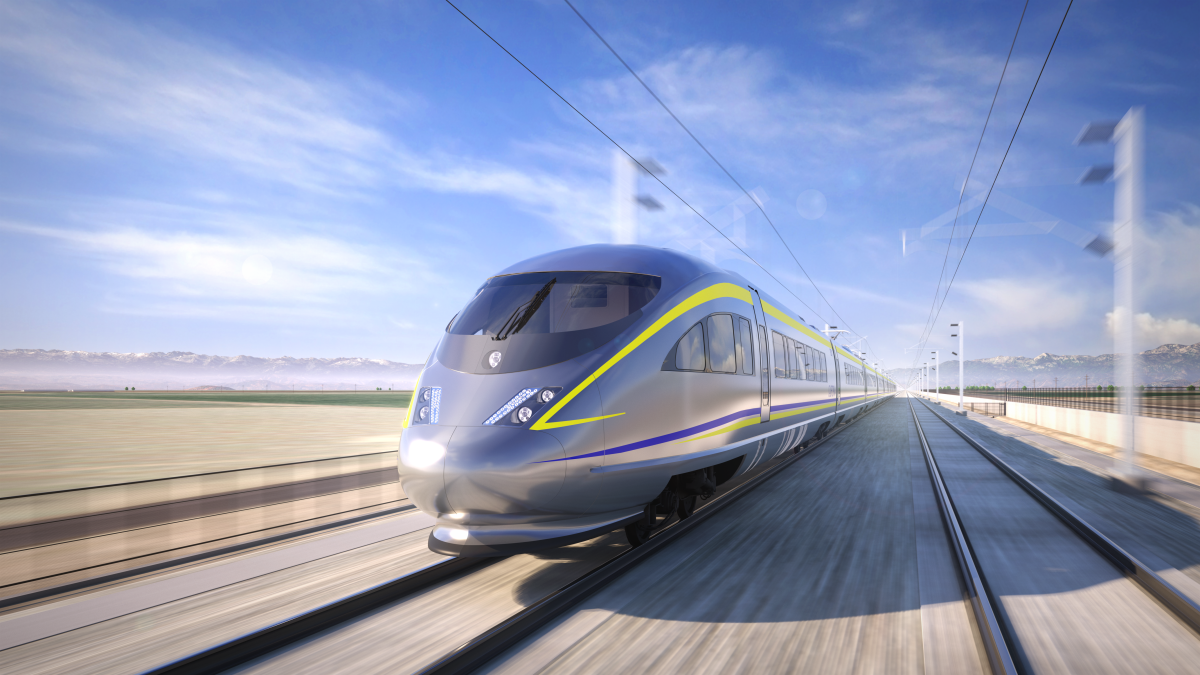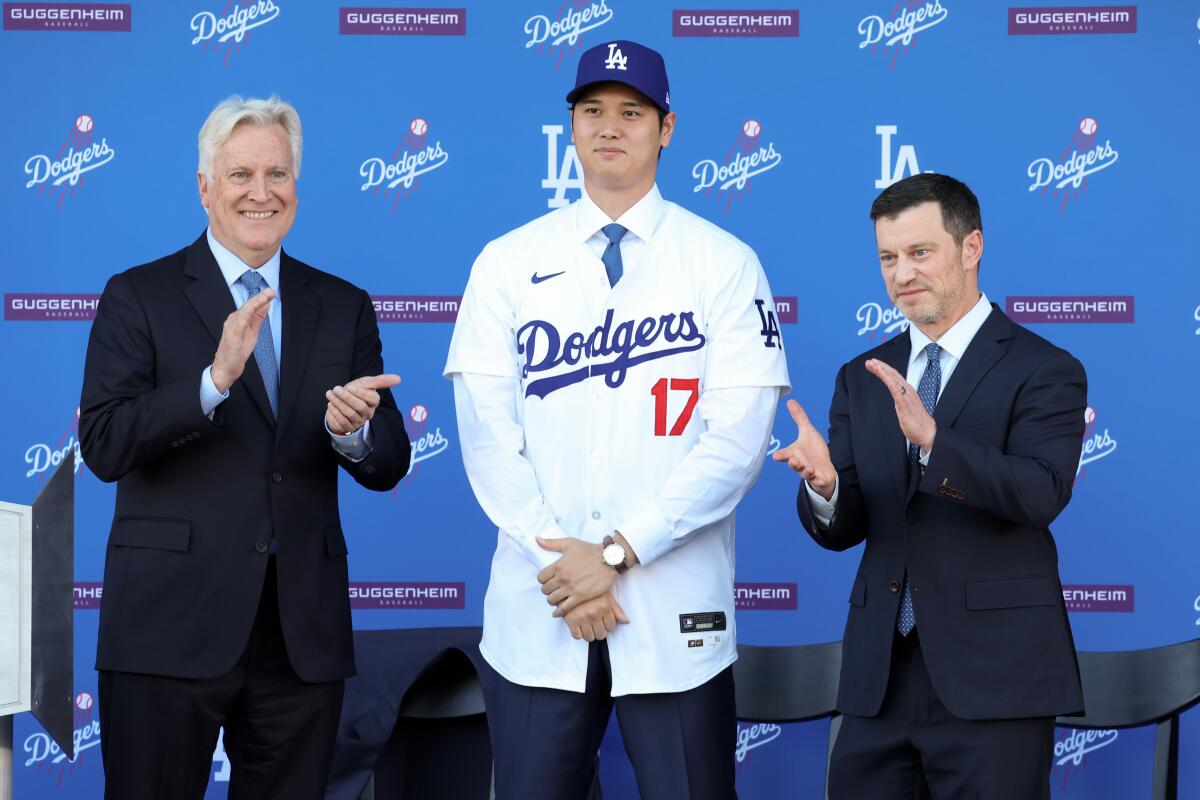High-speed rail projects in California just got billions. Can we finally have nice trains?

- Share via
Good morning. It’s Friday, Dec. 15. Here’s what you need to know to start your day.
- Why California is so totally, painfully behind on high-speed rail
- Shohei Ohtani is introduced as a Dodger
- Celebrate the holidays with 22 of the best tamales in L.A. and O.C.
- And here’s today’s e-newspaper
Sign up for Essential California
The most important California stories and recommendations in your inbox every morning.
You may occasionally receive promotional content from the Los Angeles Times.
California bullet trains: Full steam ahead?
Money talks, and last week, the federal government had about 6 billion things to say about high-speed rail projects in California.
Two projects received billions in federal grants — $3 billion for an electrified line between the Inland Empire and Las Vegas and $3.1 billion for the overdue, over-budget California high-speed rail project.
The private company Brightline is developing the SoCal-to-Vegas project, which it says will run 218 miles between Rancho Cucamonga and Las Vegas, with stops in Hesperia or Apple Valley. Existing Metrolink service will fill in the connection to downtown Los Angeles. Trains will reach 200 mph and complete the trip in about two hours, according to Brightline.
Times transportation reporter Rachel Uranga noted last week:
The company operates the only high-speed private rail service in the United States and its rapid rise runs in stark contrast to California’s effort to build a high-speed rail between Los Angeles and the Bay Area, which has been mired by politics, cost overruns and delays.
Remember that project? It’s been a while, so you’d be forgiven for forgetting. Back in 2008, after voters approved an initial $9 billion in funding for the project, officials estimated the system would be fully built and running trains by 2020. That was *checks watch* nearly four years ago. After more than a decade lag on land buying, delayed environmental reviews and legal challenges, rail officials now say they hope to have one section of the project — connecting Merced, Fresno and Bakersfield — up and running sometime between 2030 and 2033.
Many years and mph behind
Last year around this time, I took a train from Stuttgart, Germany, to Paris. The trip was roughly 310 miles — about the distance between Los Angeles and San Jose. It took just about three hours end-to-end. During that smooth, swift ride, I thought: Why can’t we get it together back home?
Japan opened the world’s first high-speed rail in 1964. That’s several years before the moon landing — and a few years before our current governor was born. France started running fast trains during Ronald Reagan’s first year as president. So why, in a state (and country) that talks a big game about ingenuity, are we so behind the high-speed-rail curve? Will we ever have nice trains?
I put those questions to Giovanni Circella, a transportation planning engineer and director of the 3 Revolutions Future Mobility Program at UC Davis. He researches ridership and economic impacts of rail projects in the state and is also wrapping up a study for the California High Speed Rail Authority focused on lessons to be learned from high-speed rail systems in Europe.
The sad state of our trains, he said, is “a side effect of the fact that the government thought there was no future for passenger railways in the U.S.”
Like the rest of our built world, it comes down to money and what our political leaders decided to prioritize with that money. In the post-WWII economic boom, more Americans bought more cars. And they wanted to drive those cars faster and to more places, leading to the interstate highway system. Around the same time, airplane travel also took off.
That “created a situation in which longer distances were covered by airplanes and the shorter distances would be covered by car,” Circella explained. “And so there was really no space remaining for railways in between. They were squeezed out with an obsolete infrastructure.”
Ridership fell sharply, as did government funding. Ray LaHood, a former U.S. secretary of Transportation, put U.S. transportation priorities into context in a guest commentary for CalMatters earlier this year:
Between 1949 and 2017, the federal government invested only $10 billion in high-speed rail with $4 billion of that dedicated to the California project, compared to investments of $777 billion in aviation and over $2 trillion in highways.
Benefits and more challenges down the line
Another challenge for California: We’re building this high-speed rail system from scratch. That’s because the typical train tracks aren’t capable of handling the speeds that bullet trains achieve.
Given this new funding, I asked Circella if he felt optimistic that high-speed rail can get back on track. He said he’s more “puzzled” than anything at this point.
Fundamentally, the technology is just an improved version of what’s been around since the early 1800s. But these new, fast electric locomotives have a lot going for them, he said:
- They’re more environmentally friendly (currently, just 2% of transportation emissions come from rail travel, while cars and trucks account for more than 80%).
- They’re more efficient in terms of moving people compared to all the space needed to move (and park) all our cars.
- They’re safer than driving, which killed more than 42,000 people in the U.S. last year.
- They can be “extremely competitive in shrinking the distance between cities,” he said, which can create more economic opportunities than our road network alone.
“I truly believe high-speed rail is a very nice mode of transportation that can provide a very comfortable and pleasant service to its riders,” Circella said. “However, especially in a place where there is no rail culture … it takes a very, very strong commitment to build the service.”
Circella sees stronger potential in the project to connect SoCal to Las Vegas. That’s because of Vegas’ more centralized hub for tourism, where people are less likely to want or need their own car to get around.
When/if the initial Central Valley section of the state’s ambitious network is completed, he expects ridership to be “disappointing.”
And that’s not surprising, given that it will connect the state’s fifth and ninth most populous cities and others with even fewer residents. But the optics of that could have a negative impact on public perception of the project as a “waste of public money.”
Something similar happened in Italy, he explained, when its initial high-speed network served smaller cities and faced public backlash. But the government stayed invested, completed the network and saw ridership soar, he said.
“The big question is, will there be political willingness [in California] to continue to invest in that to really bring the entire system to fruition?” Circella wondered.
That’s the multibillion-dollar question.
Today’s top stories

Shohei Ohtani
- Shohei Ohtani is introduced as a Dodger for the first time.
- Meet Ohtani’s surgeon, who fixes sports’ biggest stars and saved the two-way player’s $700-million arm.
- Shohei Ohtani reveals what everyone wants to know: His dog’s name.
Labor
- California embraces emergency rules to protect countertop workers from incurable silicosis.
- Federal labor regulators are looking to force Starbucks to reopen six Los Angeles-area stores that were closed in a move that was allegedly done to suppress union organizing.
Education
- As preschools and school districts close for the holidays, working parents are scrambling to find child care and provide additional meals for kids at home.
- California State University was rocked by sexual misconduct scandals. Its most powerful leaders — the Board of Trustees — were not held accountable.
- The U.S. Department of Education recently opened civil rights investigations into UCLA, UC San Diego and three other California campuses, but it is unclear whether they are related to the Israel-Palestinian conflict.
Climate and environment
- California water agencies have signed new conservation agreements to help reduce strains on the overtapped Colorado River.
- California is bracing for a stream of late December rains.
Politics
- After three years marked by scandal in City Hall, an independent government reform group is recommending a larger and more powerful Los Angeles Ethics Commission to oversee city governance.
- Former House Speaker Nancy Pelosi has endorsed Democrat Gil Cisneros in the race for a San Gabriel Valley-based House seat that is open for the first time in a generation.
- Over 1,000 migrant families were separated at the border near San Diego since September, advocates say.
More big stories
- Even before the Gaza war, antisemitism was on the rise. That has deeply unsettled many American Jews, accustomed to seeing the U.S. as a safe haven.
- A new report blames fentanyl for more fatal overdoses in L.A. County than methamphetamine for the first time in recent years. The opioid’s victims are disproportionately Black.
- The Los Angeles Times spent months researching and analyzing firearms dealer and gun violence data for its recent series on gun access. Here’s what we found.
- After California Yacht Club fire, residents mourn the loss of a beloved spot.
Get unlimited access to the Los Angeles Times. Subscribe here.
Commentary and opinions
- Brian Merchant: This was the year of AI. Next year is when you should worry about your job.
- Sammy Roth: How I learned to stop worrying and love rooftop solar.
- Michael Hiltzik: How the retail lobby sold a $45-billion whopper about organized shoplifting.
- Opinion: Love the Hollywood Burbank airport? Try living under its flight paths.
- Robin Abcarian: Who will make abortion pill rules? A bunch of right-wing judges or FDA scientists?
- LZ Granderson: DeSantis sacrifices trans teens for political points. That tells you enough about him.
- Bill Plaschke: Shohei Ohtani’s Dodgers celebration is no party for Dave Roberts.
Today’s great reads
Behind the calamitous fall of hip-hop mogul Sean ‘Diddy’ Combs. Four separate plaintiffs have filed civil lawsuits against Combs in the last month accusing him of rape, sex-trafficking a minor, assault and a litany of other alleged abuses, imperiling his empire and sending shock waves through the music industry.
Other great reads
- Who owns the memorabilia on the walls of this iconic L.A. pizzeria?
- Despite the “heartbreaking” advance of his dementia, the legendary writer behind “Deadwood” and “NYPD Blue” is still writing — with help from his wife and a longtime friend.
- Shutting a freeway in traffic-clogged L.A. gets attention. But is it effective activism?
How can we make this newsletter more useful? Send comments to [email protected].
For your downtime

Going out
- 🍽️ Celebrate the holidays with 22 of the best tamales in L.A. and O.C.
- ⛰️ Heading to Yosemite next summer? Better get a reservation.
- 🎁 Eight free holiday wallpapers, illustrated by neurodivergent artists.
Staying in
- 📺 Eddie Murphy is back in action in the fourth ‘Beverly Hills Cop’ trailer.
- 📖 I wanted to write a book of L.A. noir for decades. But first, I had to live it.
- 🧑🍳 Here’s a recipe for cinnamon holiday cake with bourbon and pecans.
- ✏️ Get our free daily crossword puzzle, sudoku, word search and arcade games.
And finally ... a great photo
Show us your favorite place in California! Send us photos you have taken of spots in California that are special — natural or human-made — and tell us why they’re important to you.

Today’s great photo is from Times photographer Jay L. Clendenin. Pictured is OnlyFans creator and entrepreneur Casey Boonstra, one of three OnlyFans millionaires we profiled who live and spend lavishly in L.A.
Have a great day, from the Essential California team
Ryan Fonseca, reporter
Elvia Limón, multiplatform editor
Kevinisha Walker, multiplatform editor
Check our top stories, topics and the latest articles on latimes.com.
Sign up for Essential California
The most important California stories and recommendations in your inbox every morning.
You may occasionally receive promotional content from the Los Angeles Times.





